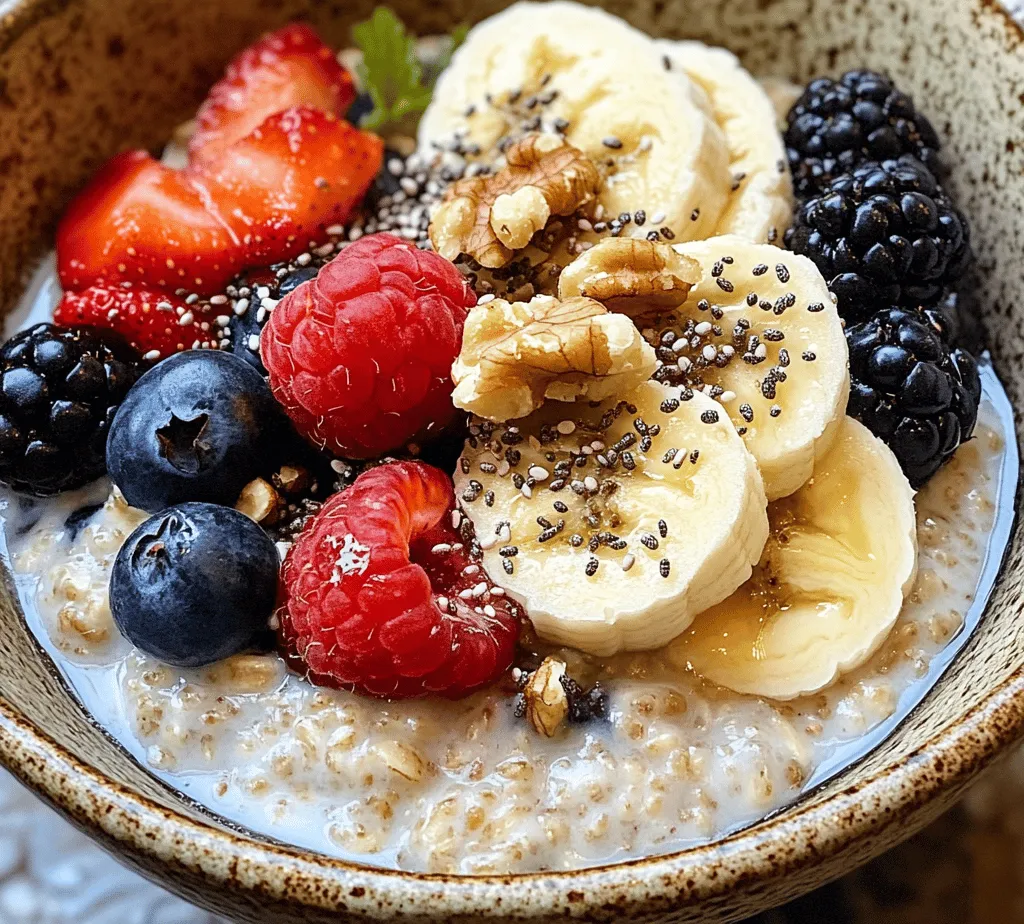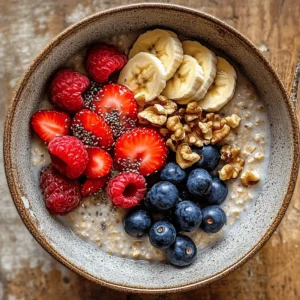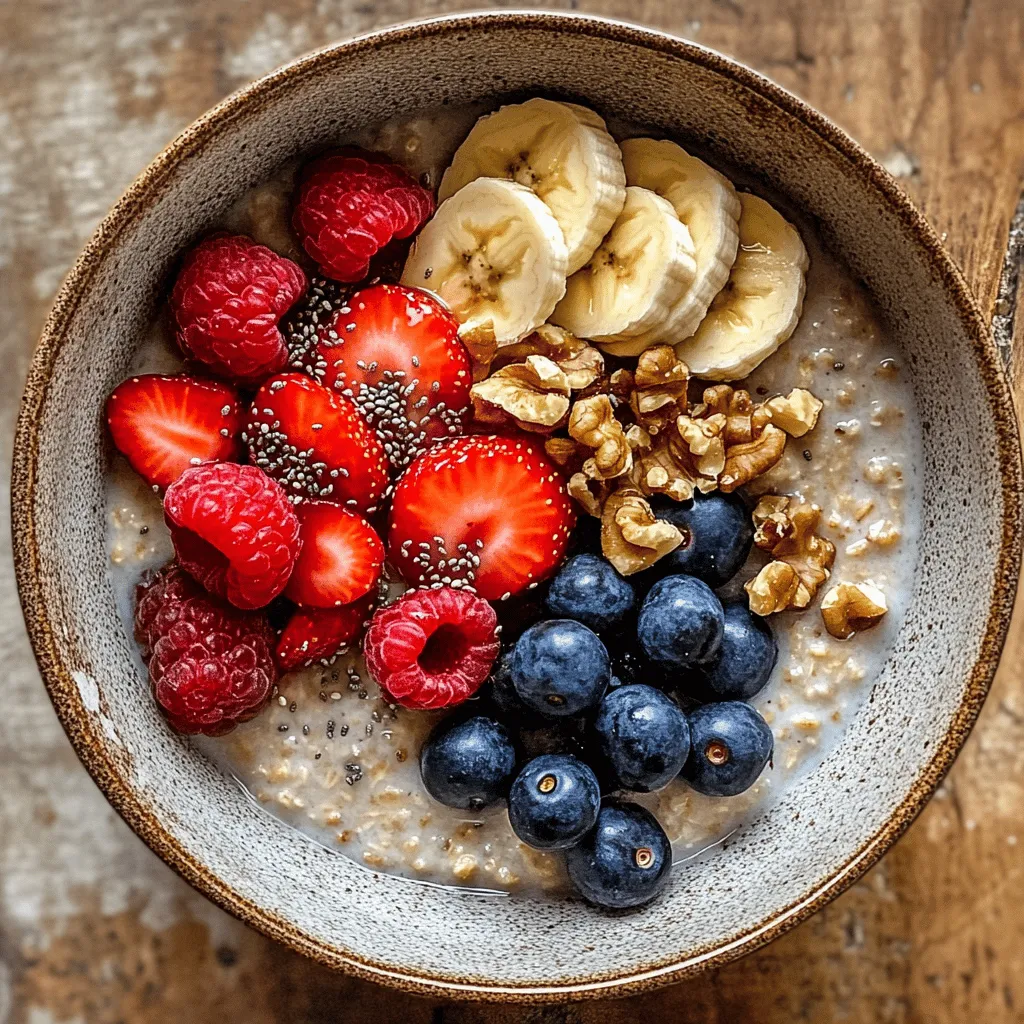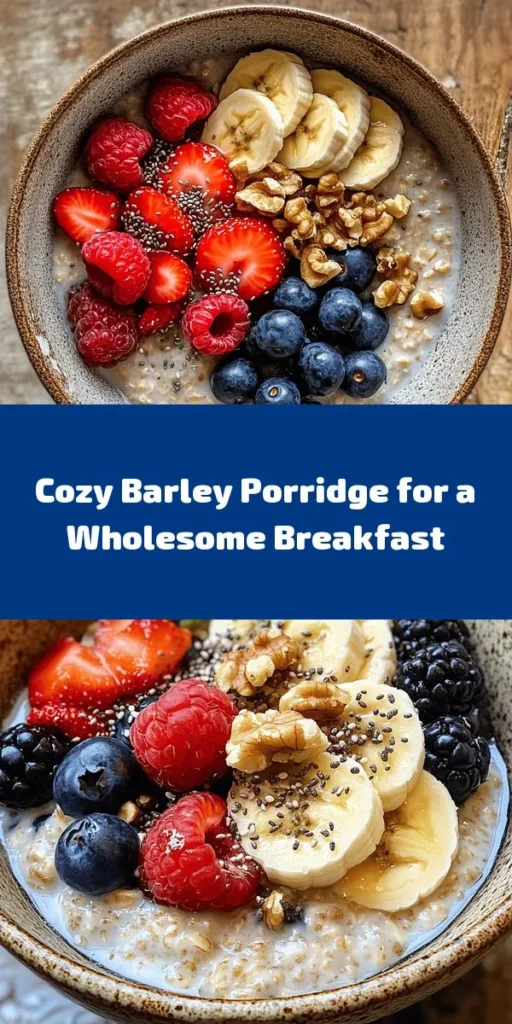Introduction
In the world of nourishing breakfast options, barley porridge stands out as a wholesome, hearty choice that promises to kick-start your day with energy and vitality. This comforting dish, often overlooked in favor of more popular grains like oats or rice, is making a comeback as health-conscious eaters rediscover the benefits of barley. Rich in fiber and packed with essential nutrients, barley porridge not only satisfies your hunger but also supports your overall well-being.
Barley, particularly in its pearl form, serves as the star ingredient of this porridge. It boasts numerous health benefits, such as aiding digestion, regulating blood sugar levels, and promoting heart health. With a chewy texture and nutty flavor, barley offers a satisfying base that can be customized to your liking. Whether you prefer a traditional preparation with warm spices or a more adventurous mix with seasonal fruits and nuts, the versatility of barley porridge allows you to create a dish that suits your taste preferences and dietary needs.
In this recipe, we will explore the process of making warm and wholesome barley porridge, along with delicious toppings and flavor combinations that enhance its appeal. Join us as we delve into the world of barley, uncover its nutritional benefits, and learn how to craft the perfect bowl of porridge that you can enjoy any day of the week.
Understanding Barley
Barley is a cereal grain that has been cultivated for thousands of years, making it one of the oldest cultivated grains in human history. Its resilience and adaptability have allowed it to thrive in various climates, leading to its widespread use in different cultures around the globe. Barley is available in several forms, but pearl barley is the most common for porridge due to its refined texture and quick cooking time.
Nutritional Profile of Pearl Barley
Pearl barley is the polished version of hulled barley, which means it has had its outer bran removed, resulting in a softer texture. Despite the processing, pearl barley still retains a significant amount of its nutritional benefits. Here’s a breakdown of the nutritional profile of pearl barley per 100 grams:
– Calories: Approximately 352
– Protein: 12.5 grams
– Fat: 1.2 grams
– Carbohydrates: 73.5 grams
– Dietary Fiber: 17.3 grams
– Vitamins and Minerals: Barley is a rich source of several vitamins and minerals, including B vitamins (especially niacin, thiamine, and riboflavin), iron, magnesium, phosphorus, and selenium.
Health Benefits of Consuming Barley
Incorporating barley into your diet can yield numerous health benefits, making it an excellent choice for those looking to enhance their nutrition. Here are some of the key benefits associated with barley consumption:
1. High in Fiber: Barley is an excellent source of soluble and insoluble dietary fiber, which aids digestion, promotes regular bowel movements, and helps maintain a healthy gut microbiome. The soluble fiber in barley can also help lower cholesterol levels.
2. Blood Sugar Regulation: The low glycemic index of barley means that it helps stabilize blood sugar levels, making it a beneficial food for individuals with diabetes or those looking to manage their weight.
3. Heart Health: Regular consumption of barley has been linked to improved heart health, as its fiber content helps lower cholesterol and blood pressure levels.
4. Nutrient-Dense: With a wealth of vitamins and minerals, barley contributes to overall health and wellness, supporting various bodily functions.
5. Versatile for Diets: Barley is not only vegan-friendly but also offers gluten-free options (hulled barley) for those with gluten sensitivities. This makes it a suitable addition to a variety of dietary lifestyles.
By understanding the nutritional benefits of barley, you can appreciate why it deserves a place in your pantry and on your breakfast table.
Ingredients Breakdown
Now that we’ve established the health benefits and versatility of barley, let’s take a closer look at the specific ingredients used in our warm and wholesome barley porridge recipe. Each ingredient plays a crucial role in contributing to the flavor, texture, and nutritional profile of the dish.
Pearl Barley
As the fundamental ingredient in this recipe, pearl barley provides not only the base for the porridge but also a wealth of nutrients.
– Benefits: Pearl barley is rich in fiber, which aids digestion and promotes satiety. It also contains essential vitamins and minerals that contribute to overall health.
– Cooking Methods: To prepare pearl barley for porridge, it’s best to rinse it under cold water to remove any dust or debris. The typical cooking ratio is 1 cup of pearl barley to 3 cups of water or broth. Bring the liquid to a boil, reduce the heat, and simmer for about 30-40 minutes until tender.
– Storage Tips: Store pearl barley in a cool, dry place in an airtight container. It can last for several months, making it a convenient pantry staple.
Water or Vegetable Broth
Adding liquid is essential for cooking the barley and creating a creamy porridge texture. You can use either water or vegetable broth, depending on your flavor preference.
– Flavor Enhancement: Using vegetable broth infuses the porridge with additional flavors, making it more savory and satisfying.
– Nutritional Value: Broth can add extra vitamins and minerals to the dish, especially if made from fresh vegetables.
Almond Milk
For those who prefer a plant-based option, almond milk is an excellent choice for adding creaminess to the porridge.
– Benefits of Plant-Based Milk: Almond milk is low in calories and packed with vitamin E, an antioxidant that supports skin health and immune function. It also has a subtle nutty flavor that complements the barley nicely.
– Alternatives: If almond milk isn’t available or you have allergies, other plant-based milks like oat milk, soy milk, or coconut milk can be used as substitutes.
Maple Syrup or Honey
To sweeten your barley porridge naturally, you can use either maple syrup or honey.
– Natural Sweeteners: Both options provide a delicious sweetness without the artificial ingredients found in many processed sugars.
– Health Benefits: Maple syrup contains antioxidants and minerals like manganese and zinc, while honey has antibacterial properties and can soothe sore throats.
Vanilla Extract
Adding vanilla extract enhances the flavor profile of the porridge, making it aromatic and inviting.
– Flavor Profile: Vanilla provides a warm, sweet note that complements the nuttiness of the barley.
– Sourcing Quality Vanilla: When choosing vanilla extract, opt for pure vanilla extract rather than imitation vanilla for the best flavor.
Cinnamon
Cinnamon is a classic spice that not only adds warmth and depth to the porridge but also offers health benefits.
– Health Benefits: Cinnamon is known for its anti-inflammatory and antioxidant properties. It may also help lower blood sugar levels and improve insulin sensitivity.
– Flavor Enhancement: A sprinkle of cinnamon elevates the overall flavor, making the porridge taste even more comforting and delicious.
Salt
Though it may seem counterintuitive to add salt to a sweet dish, a pinch of salt is essential for balancing flavors.
– Importance of Seasoning: Salt enhances the sweetness of the porridge and elevates the overall flavor profile. It’s a crucial component in many recipes, including sweet ones, to ensure a well-rounded taste.
With these ingredients in mind, you’re well on your way to preparing a nourishing and delicious bowl of warm barley porridge. Stay tuned as we move forward to the step-by-step instructions for crafting this wholesome breakfast delight, packed with flavor and nutrition.

Toppings
When it comes to enhancing your warm and wholesome barley porridge, the right toppings can elevate the dish from simple to extraordinary. Adding fruits, nuts, and chia seeds not only boosts the flavor but also enhances the nutritional profile of your meal.
Nutritional Benefits of Fruits, Nuts, and Chia Seeds
– Fruits: Fresh fruits such as berries, bananas, and apples are not only visually appealing but also packed with vitamins, antioxidants, and fiber. Berries, for instance, are rich in antioxidants that can help combat oxidative stress, while bananas provide potassium that supports heart health and muscle function.
– Nuts: Nuts add a delightful crunch and bring healthy fats, protein, and essential nutrients. Almonds and walnuts are excellent choices, as they contain omega-3 fatty acids that promote brain health and help reduce inflammation.
– Chia Seeds: These tiny seeds are a powerhouse of nutrition. Rich in omega-3 fatty acids, fiber, and protein, chia seeds can help keep you full longer and support digestive health. Adding them to your porridge not only enhances the texture but also increases the overall nutritional content.
Step-by-Step Cooking Instructions
Cooking barley porridge may seem straightforward, but a few key steps can make a significant difference in the final dish’s texture and flavor.
Rinsing the Barley
Before you start cooking, it’s essential to rinse the barley thoroughly. Rinsing helps remove any dust, debris, or residual starch that can cause the porridge to become gummy. Place the barley in a fine-mesh strainer and rinse it under cold running water for about 1-2 minutes until the water runs clear. This simple step enhances the final dish, ensuring a creamy and smooth porridge.
Cooking the Barley
Once rinsed, it’s time to cook the barley. In a medium saucepan, combine 1 cup of rinsed barley with 4 cups of water or vegetable broth for added flavor. Bring the mixture to a boil over medium-high heat. Once boiling, reduce the heat to low, cover the pot, and let it simmer for approximately 30-40 minutes. The barley should be tender but still chewy. If you prefer a softer texture, extend the cooking time by a few minutes, checking periodically for doneness.
Incorporating Milk and Flavorings
To achieve that creamy texture characteristic of a delightful porridge, slowly stir in 1-2 cups of milk (dairy or plant-based) after the barley has cooked. Start with 1 cup, and as you stir, assess the consistency. If you prefer a creamier porridge, you can add more milk to reach your desired texture. Enhance the flavor profile by adding a pinch of salt, cinnamon, or vanilla extract. These additions not only elevate the taste but also create a warming aroma that fills your kitchen.
Adjusting Thickness
Thickness is a matter of personal preference when it comes to porridge. If you find your porridge too thick, simply add a splash of water or milk and stir until you reach the desired consistency. Conversely, if it’s too thin, allow it to simmer uncovered for a few more minutes to thicken. Remember, the porridge will continue to thicken as it cools, so adjust accordingly before serving.
Serving Suggestions
Now that your barley porridge is perfectly cooked and creamy, it’s time to serve! Personalizing your porridge with toppings can transform it into a delightful breakfast experience. Here are some ideas for toppings:
1. Fresh Fruits: Top your porridge with slices of fresh banana, a handful of blueberries, or diced apples. For a seasonal touch, consider using strawberries in spring or roasted pears in winter.
2. Nuts and Seeds: Sprinkle a mix of chopped almonds, walnuts, or pecans over the top for added crunch and healthy fats. Adding a tablespoon of chia seeds or flaxseeds can also boost the nutritional value.
3. Sweeteners: Drizzle a touch of honey, maple syrup, or agave nectar for a hint of sweetness. Alternatively, try a dollop of nut butter for a rich, satisfying flavor.
4. Spices: A sprinkle of cinnamon or nutmeg can enhance the flavor profile, giving your porridge a warm and cozy feel. For a unique twist, try adding cardamom.
5. Dairy or Plant-Based Alternatives: Finish with a splash of cream, yogurt, or a scoop of your favorite plant-based yogurt for extra creaminess and tang.
Nutritional Benefits of Barley Porridge
Barley porridge is not only delicious but also packed with nutritional benefits that make it an excellent choice for breakfast.
Insight into the Health Benefits of Each Ingredient
– Barley: A whole grain, barley is high in fiber, particularly beta-glucans, which are known to help lower cholesterol levels. It also contains essential nutrients such as magnesium, iron, and B vitamins, contributing to overall health.
– Milk: Whether you choose dairy milk or a plant-based alternative, milk provides a good source of calcium and vitamin D, both essential for bone health.
– Fruits and Nuts: As previously mentioned, fruits and nuts add a variety of vitamins, minerals, and healthy fats. This combination helps support immune function and promotes heart health.
How This Porridge Contributes to a Balanced Breakfast
A balanced breakfast should include a mix of carbohydrates, proteins, and healthy fats. Barley porridge ticks all these boxes, providing complex carbohydrates for sustained energy, protein from milk and nuts, and healthy fats from nuts and seeds. This nutritional balance helps keep you full and satisfied throughout the morning.
Exploration of How Barley Porridge Supports Digestive Health and Energy Levels
The high fiber content in barley supports digestive health by promoting regular bowel movements and feeding beneficial gut bacteria. This can lead to improved gut health and overall well-being. Additionally, the slow-releasing carbohydrates in barley provide a steady source of energy, helping you to avoid the mid-morning slump often associated with sugar-laden breakfasts.
Creative Variations of Barley Porridge
While the classic version of barley porridge is delightful, there are numerous ways to customize and experiment with flavors to keep your breakfast routine exciting.
Suggestions for Flavor Variations
– Chocolate Barley Porridge: Stir in a tablespoon of cocoa powder for a chocolatey twist. Top with banana slices and a drizzle of almond butter for an indulgent yet healthy option.
– Spiced Apple Barley Porridge: Cook diced apples with cinnamon and nutmeg in the porridge for a warm, comforting flavor. Top with walnuts for a delightful crunch.
– Maple Pecan Barley Porridge: Add maple syrup during cooking, and finish with toasted pecans and a sprinkle of cinnamon. This combination offers a sweet and nutty flavor profile.
Ideas for Seasonal Toppings
– Spring/Summer: Use fresh berries like strawberries, blueberries, or raspberries, and a dollop of coconut yogurt to keep things light and refreshing.
– Fall/Winter: Experiment with roasted pumpkin, chopped pecans, and a drizzle of maple syrup for a seasonal delight.
Savory Options
For those who prefer a savory breakfast, barley porridge can easily be transformed. Consider adding sautéed vegetables like spinach, mushrooms, and bell peppers. Season with herbs and spices such as thyme, rosemary, or a dash of hot sauce for an exciting twist. Combining barley with a poached egg on top can create a satisfying and nourishing meal that’s perfect for any time of the day.
Conclusion
In summary, warm and wholesome barley porridge is more than just a breakfast option; it’s a comforting, nutritious meal that can be easily customized to suit your tastes and dietary needs. The combination of barley, milk, and a variety of toppings not only satisfies hunger but also nourishes your body with essential nutrients.
I encourage you to try this recipe and explore the various toppings and flavor variations available. Whether you enjoy it sweet or savory, barley porridge is a fantastic way to incorporate whole grains into your diet, providing warmth, nourishment, and countless health benefits. Embrace the versatility of barley and enjoy a wholesome start to your day!



